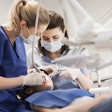
The year 2010 certainly wasn't a quiet one in dentistry. From legislative reforms and Medicaid cutbacks to new workforce models and concerns over environmental and health risks, this industry has become more vocal and political than ever before -- with a trend toward polarization in the process.
While the signing of the healthcare reform law in March could be considered the top story of the year -- yielding a variety of ruminations about what the new law might mean for dental care providers and patients in the long run -- economic turbulence had a more immediate impact on dentistry in 2010.
Faced with looming budget deficits, a number of states -- including California, Hawaii, Washington, Arizona, Kansas, Minnesota, Massachusetts, and Ohio -- drastically reduced their Medicaid adult dental services this year. Some, such as Idaho, sought to decrease Medicaid spending in other ways -- by cutting back on the number of dentists who could provide Medicaid services.
And although Medicaid kids' dental care continues to be protected by the Children's Health Insurance Program, which is being expanded as a part of the healthcare reform law, a report issued November 30 by the U.S. Government Accountability Office revealed that millions of Medicaid children are still not getting adequate dental care.
|
Top 10 stories for 2010
|
In addition, with U.S. unemployment rates hovering around 10% for much of this year and last, many patients have lost their insurance benefits and the ability to pay out of pocket for dental care. An estimated 45 million Americans do not currently have dental insurance, according to a report released in June by the Centers for Disease Control and Prevention (CDC).
Access-to-care crisis
These issues have put the challenge of improving access to oral healthcare -- especially for underserved populations -- on the front burner at both the state and federal levels. In West Virginia, for example, a unique program is creating dental clinics in elementary schools, while a program in North Carolina is successfully training primary care physicians to conduct oral health assessments and even apply varnish in patients ages 1 to 3.
At the national level, the U.S. government this year unveiled Oral Health Initiative 2010, designed to get preventive care to Medicaid and Head Start children, strengthen the dental workforce, and increase oral health research and public awareness in the U.S. In addition, the CDC and the National Institutes of Health are now developing a first-ever comprehensive National Oral Health Surveillance Plan that would monitor oral diseases, conditions, and oral health-related behaviors in the U.S. population.
And for three years the American Academy of Pediatric Dentistry (AAPD) has partnered with the U.S. Office of Head Start (OHS) to develop a network of pediatric dentists and general dentists in nearly 30 states who provide care to children involved in Head Start -- the so-called Dental Home Initiative. And yet, while the program has been deemed a success by everyone involved, the OHS has decided to take over the project from the AAPD starting January 1 -- a move that has many involved with the project concerned about its future.
But the access-to-care crisis has also spurred the most heated debate in dentistry this year: new workforce models -- namely, midlevel providers. Some argue that the access-to-care issue is the result of a dentist shortage, while others say it is a matter of maldistribution. Some believe that midlevel providers are a logical -- and proven -- solution, while others contend that they will be unable to provide adequate care.
In fact, while a two-year evaluation of the Alaskan dental health aide therapists program released in October concluded that these midlevel providers are providing safe and competent care to residents of remote and underserved native communities, numerous dental organizations took issue with the survey and its sponsor, the Kellogg Foundation. Even so, Kellogg is moving forward with a $16 million initiative to fund several more midlevel provider pilot programs in the U.S.
Fundamental principles
Many of dentistry's "nuts and bolts" were up for debate this year as well. Foremost among these was dental amalgam. Under pressure from various consumer groups to reconsider its position on this mercury-based restorative, the FDA held a two-day public hearing in December that drew dozens of opponents and supporters.
While the advisory panel that heard their often touching testimony didn't draw any definitive conclusions, the FDA is now considering the panel's conclusions before determining whether to change how it regulates dental amalgam
Meanwhile, the U.S. Environmental Protection Agency announced in September that it intends to require dental offices to install amalgam separators to reduce the amount of mercury that goes into waste treatment plants. And the World Health Organization is about to issue a report that confirms the ongoing need for amalgam and outlines the risks of an outright ban; however, the report also lays the groundwork for global amalgam use-reduction laws.
Concerns about the safety of bisphenol A (BPA), another chemical found in some dental materials, also made headlines in 2010. Canada officially declared BPA to be toxic, making it easier to regulate the chemical in all kinds of products; the FDA raised its assessment of bisphenol A to a chemical of concern; and the National Institute of Environmental Health Sciences launched 11 new animal studies -- at a cost of $20 million -- to investigate the possible effects of BPA.
Water fluoridation continued to raise hackles as well. Despite reams of evidence supporting its salutary effects, cities and towns across the U.S. rallied against fluoridating their water supplies this year, citing issues of personal liberty and potential health risks. But one California community -- Watsonville -- that had fought against fluoridating its water supply for nearly a decade finally approved it in September after state officials threatened fines for failing to comply with a state law requiring it.
Third-molar extractions were another topic of heated discussion this year. While the American Association of Oral and Maxillofacial Surgeons sought to cease the debate this year by releasing 10 years' worth of research supporting the prophylactic removal of third molars, not everyone is convinced.
The idea of dentists giving Botox injections stirred similar strong feelings, both for and against. A growing number of dentists are now offering this therapy to their patients to improve appearances and alleviate pain -- a practice that, while lucrative, is also inciting the ire of dermatologists, plastic surgeons, and some of their colleagues.
Consumer concerns
In addition to dental Botox, a number of stories this year focused on consumer-related products and therapies. The FDA issued warnings about mouthwash claims, triclosan in toothpaste, and the risks of getting burned by dental handpieces. There were also ongoing lawsuits involving zinc-based denture creams and the apparent relationship between oral bisphosphonates and osteonecrosis of the jaw.
The rising incidence of oral cancer took on a higher profile as well, following actor Michael Douglas' revelation that he has stage IV oropharyngeal cancer and a growing body of research showing that tobacco is no longer the leading cause of this disease. An increase in the number of pediatric deaths following dental procedures points to another disturbing trend: Sedation is becoming more common in pediatric dental procedures because more children are developing caries at younger ages and often need extensive work.
Children were also the focus of a New York Times article that highlighted the risks associated with exposure to cone-beam CT radiation during dental treatment. The Times claimed that proponents overhype the technology and underplay the radiation risks, but imaging experts say the real issue is one of professional judgment.
Finally, we can't say good-bye to 2010 without paying tribute to the outpouring of support that the dental community has shown this year in response to the needs of those affected by economic and environmental disasters. Dental professionals were among the first responders to the earthquake in Haiti, and they showed up in droves across the U.S. to volunteer their time and services at Dentistry from the Heart events and Mission of Mercy free clinics. Halloween candy buyback programs, smile makeover contests, and free oral cancer screenings raised money to help the underserved, and, of course, there were numerous grants, gifts, and product donations that made so many of these events possible in the first place.
It was a challenging year for dentistry, but a gratifying one in many ways too. Let's hope many of these trends continue in 2011, pushing the importance of oral health to the forefront of social discussion and decision-making.
Copyright © 2010 DrBicuspid.com















